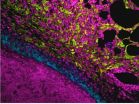(Press-News.org) This press release is available in Spanish.
Corn crop residues are often left on harvested fields to protect soil quality, but they could become an important raw material in cellulosic ethanol production. U.S. Department of Agriculture (USDA) research indicates that soil quality would not decline if post-harvest corn cob residues were removed from fields.
This work, led by Agricultural Research Service (ARS) soil scientist Brian Wienhold, supports the USDA priority of developing new sources of bioenergy. ARS is USDA's chief intramural scientific research agency.
Wienhold , with the ARS Agroecosystem Management Research Unit in Lincoln, Neb., led studies that compared runoff rates and sediment loss from no-till corn fields where postharvest crop residues were either removed or retained. The scientists also removed cobs from half of the test plots that were protected by the residues.
After the test plots were established, the scientists generated two simulated rainfall events. The first occurred when the fields were dry, and the next occurred 24 hours later when the soils were almost completely saturated.
During the first event, on plots where residue was removed, runoff began around 200 seconds after the "rain" began. Runoff from plots protected by residues didn't start until around 240 seconds after it started to "rain."
Runoff from the residue-free plots contained 30 percent more sediment than runoff from all the residue-protected plots. But the presence or absence of cobs on the residue-protected plots did not significantly affect sediment loss rates.
Wienhold's team concluded that even though cob residues did slightly delay the onset of runoff, sediment loss rates were not significantly affected by the presence or absence of the cobs. The results indicated that the cobs could be removed from other residue and used for bioenergy feedstock without significantly interfering with the role of crop residues in protecting soils.
In a related study, Wienhold examined how the removal of cob residues affected soil nutrient levels. Over the course of a year, his sampling indicated that cobs were a source of soil potassium, but that they weren't a significant source of any other plant nutrients.
###
Read more about this research in the January 2013 issue of Agricultural Research magazine.
USDA is an equal opportunity provider and employer. To file a complaint of discrimination, write: USDA, Office of the Assistant Secretary for Civil Rights, Office of Adjudication, 1400 Independence Ave., SW, Washington, DC 20250-9410 or call 866-632-9992 (Toll-free Customer Service), 800-877-8339 (Local or Federal relay), 866-377-8642 (Relay voice users). END
Corn cobs eyed for bioenergy production
2013-01-31
ELSE PRESS RELEASES FROM THIS DATE:
Gum disease found to worsen infection in animal model of AIDS
2013-01-31
Texas Biomed scientists in San Antonio have found that moderate gum disease in an animal model exposed to an AIDS- like virus had more viral variants causing infection and greater inflammation. Both of these features have potential negative implications in long term disease progression, including other kinds of infections, the researchers say in a new report.
The public health message from the study is that even mild inflammation in the mouth needs to be controlled because it can lead to more serious consequences, said Luis Giavedoni, Ph. D, a Texas Biomed virologist and ...
Flat boron by the numbers
2013-01-31
It would be a terrible thing if laboratories striving to grow graphene from carbon atoms kept winding up with big pesky diamonds.
"That would be trouble, cleaning out the diamonds so you could do some real work," said Rice University theoretical physicist Boris Yakobson, chuckling at the absurd image.
Yet something like that keeps happening to experimentalists working to grow two-dimensional boron. Boron atoms have a strong preference to clump into three-dimensional shapes rather than assemble into pristine single-atom sheets, like carbon does when it becomes graphene. ...
New study highlights impact of environmental change on older people
2013-01-31
Recent natural disasters illustrate vulnerability of older people: majority of deaths from the Great East Japan Earthquake (2011) and Hurricane Katrina (2005) occurred among older people.
Researchers at the Stockholm Environment Institute at the University of York and Simon Fraser University's Gerontology Research Centre in Canada are calling for better awareness among policy makers and the public of the impact climate change and deteriorating environmental quality will have on an ageing population.
According to UN projections, by 2050, nearly 25 per cent of the global ...
UNC study may lead to treatments that are effective against all MRSA strains
2013-01-31
CHAPEL HILL, N.C. – In the last decade, a new strain of MRSA has emerged that can spread beyond hospital walls, putting everyone at risk of contracting the dangerous bacterial infection. This particular strain of MRSA – known as USA300 – contains a chunk of genes not shared by any other strains, though it is unclear how this unique genetic material enables the bacteria to survive and persist in the community.
Now, research from the University of North Carolina School of Medicine has pinpointed a gene that causes the infection to linger on the skin longer than other strains, ...
How the tilt of a cell-surface receptor prevents cancer
2013-01-31
January 31, 2013, New York, NY and Brussels, Belgium – Clear communication between cells is essential to every aspect of the body's internal function. But since cells can't talk, or send emails, how do they communicate?
The answer, in a nutshell, is by dispatching signaling molecules that selectively bind to protein receptors on the outer surface of other cells with which they must "talk." This activates the tail end of such receptors inside the cell, initiating a cascade of enzymatic reactions, or signaling pathways that reach into the nucleus, turning genes on and off. ...
1 of the key circuits in regulating genes involved in producing blood stem cells is deciphered
2013-01-31
Researchers from the group on stem cells and cancer at IMIM (Hospital del Mar Medical Research Institute) have deciphered one of the gene regulation circuits which would make it possible to generate hematopoietic blood cells, i.e. blood tissue stem cells. This finding is essential to generate these cells in a laboratory in the future, a therapy that could benefit patients with leukaemia or other diseases who need a transplant and who, in many cases, do not have a compatible donor.
In the process of generating stem cells, many molecule signals intervene which, through ...
In the planetary nursery
2013-01-31
This press release is available in German.
The disk surrounding the young star TW Hydrae is regarded as a prototypical example of planetary nurseries. Due to its comparatively close proximity of 176 light-years, the object plays a key role in cosmological birth models. Using the Herschel Space Telescope, researchers including Thomas Henning from the Max Planck Institute for Astronomy in Heidelberg have, for the first time, determined the mass of the disk very precisely. The new value is larger than previous estimates and proves that planets similar to those of our solar ...
A positive family climate in adolescence is linked to marriage quality in adulthood
2013-01-31
Experiencing a positive family climate as a teenager may be connected to your relationships later in life, according to new research published in Psychological Science, a journal of the Association for Psychological Science.
While research has demonstrated long-term effects of aggression and divorce across generations, the impact of a positive family climate has received less attention. Psychological scientist Robert Ackerman of the University of Texas at Dallas and colleagues wanted to examine whether positive interpersonal behaviors in families might also have long-lasting ...
Zebrafish may hold the answer to repairing damaged retinas and returning eyesight to people
2013-01-31
Zebrafish, the staple of genetic research, may hold the answer to repairing damaged retinas and returning eye-sight to people.
University of Alberta researchers discovered that a zebrafish's stem cells can selectively regenerate damaged photoreceptor cells.
Lead U of A researcher Ted Allison says that for some time geneticists have known that unlike humans, stem cells in zebrafish can replace damaged cells involved in many components of eyesight. Rods and cones are the most important photoreceptors. In humans, rods provide us with night vision while cones give us a full ...
Time spent watching television is not associated with death among breast cancer survivors
2013-01-31
Spending a lot of time watching television after breast cancer diagnosis is not linked to death in these breast cancer survivors. It appears that after accounting for self-reported physical activity levels after diagnosis, sedentary behavior was not an independent risk factor for death. These findings by Stephanie George, from the National Cancer Institute, and her colleagues, are published online in Springer's Journal of Cancer Survivorship.
On the one hand, research indicates that taking part in regular, moderate-to-vigorous intensity physical activity after a breast ...

